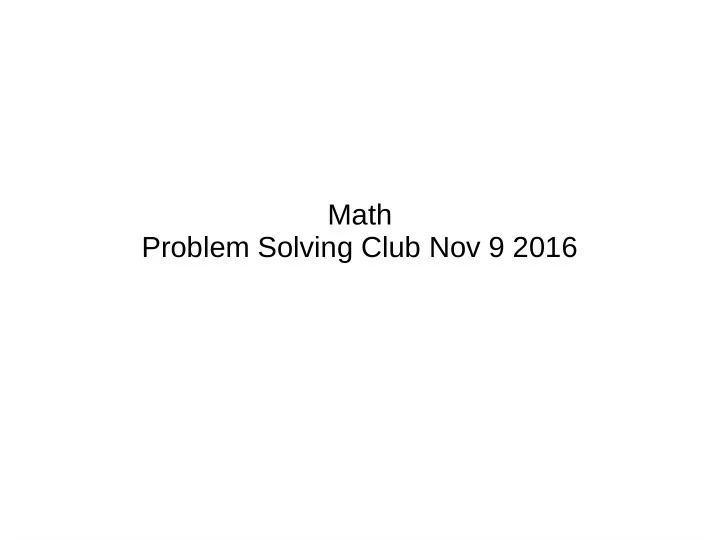

Math Problem Solving Club Nov 9 2016
N mathematicians walk into a bar. The first orders 1 beer, the second orders ½ a beer, the third orders ¼ a beer and so on The bartender says stupid mathematicians and gives them 2 beers
Modular arithmetic ● Modular arithmetic is a system of arithmetic for integers, where numbers "wrap around" upon reaching a certain value—the modulus ● If a ≡ b (mod m), a and b are said to be congruent modulo m ● 1 ≡ 13 (mod 12) ● 1 ≡ 25 (mod 12) ● -1 ≡ 11 (mod 12)
Properties of modular arithmetic ● Which of the following is true? If a ≡ b (mod m) and c ≡ d (mod m) ● a+c ≡ b+d (mod m) ● a-c ≡ b-d (mod m) ● a×c ≡ b×d (mod m) ● a c ≡ b d (mod m) ● a c ≡ a d (mod m) ● a c ≡ b c (mod m) ● a÷c ≡ b÷d (mod m)
Modulo operation ● In computing, the modulo operation finds the remainder after division of one number by another ● 25 % 12 = – Answer: 1 ● (-1) % 12 = – In C++/Java: -1 – In Python: 11 ● Problems frequently want the answer modulo m , which usually means the non-negative remainder when the answer is divided by m. ● (a+b)%m = (a%m + b%m)%m ● (a-b)%m = (a%m - b%m)%m ● (a*b)%m = ((a%m)*(b%m))%m
Greatest common divisor ● gcd(a, b) is the largest integer that divides both a and b ● For example, gcd(8, 12) = 4 ● What is gcd(60, 45)? ● How do you compute gcd(a, b)? – Euclidean algorithm – function gcd(a, b) – if b = 0 – return a; – else – return gcd(b, a % b);
Exponentiation by squaring ● How can we calculate a b ? ● Naive exponentiation: O(b) ● Observe that x n = – If n is even, then (x n/2 ) 2 – If n is odd, then x(x (n-1)/2 ) 2 ● What is the time complexity of evaluating? – O(log b) ● This can be also used for raising matrices to high powers (e.g. finding the n’th Fibonacci number)
Modular inverse ● (a/b) % m ≠ ((a%m) / (b%m)) % m ● How can we do modular division? – We can sometimes use a modular inverse ● If a -1 is the modular multiplicative inverse of a modulo m, then aa -1 = 1 (mod m) – Now (a/b) % m = ((a%m) * ((b -1 )%m)) % m ● When does the modular inverse exist? – The multiplicative inverse of a modulo m exists if and only if a and m are coprime (i.e., if gcd(a, m) = 1).
Finding the modular inverse ● How do we compute modular inverses? ● Approach 1: Extended euclidean algorithm – Generally the fastest and easiest approach – A slightly modified version of the Euclidean algorithm can find modular inverses ● Approach 2: Euler’s (or Fermat’s little) theorem – a φ(m)-1 ≡ a -1 (mod m) where φ(m) is Euler's totient function (positive integers up to a given integer n that are relatively prime to n) – For a prime modulus p, a p-2 ≡ a -1 (mod p) – Use exponentiation by squaring
Logarithms ● Useful properties of logarithms: – log(a×b) = log a + log b – log(a÷b) = log a – log b – log(a b ) = b log a ● How do you find the number of digits in a number? – log 10 (1) = 0 – log 10 (2) ≈ 0.3010 – log 10 (999) ≈ 2.9996 – log 10 (1000) = 3 – log 10 (1001) ≈ 3.0004 ● The number of digits in n is log ⌊ 10 (n) + 1 ⌋
Recommend
More recommend